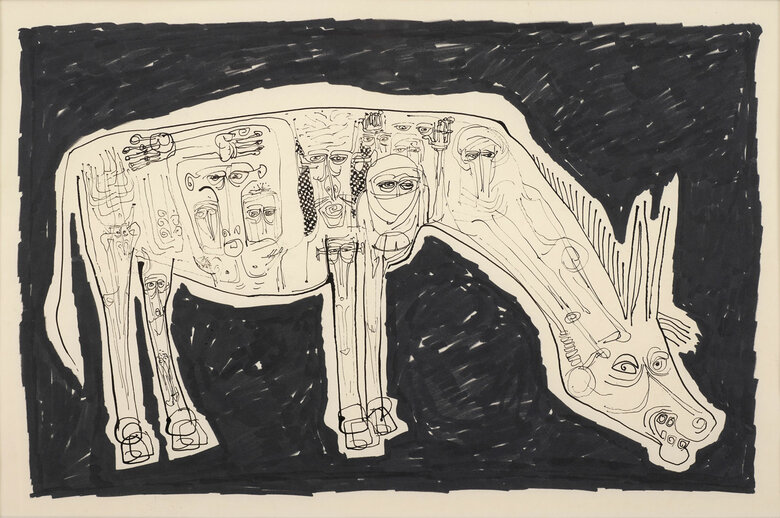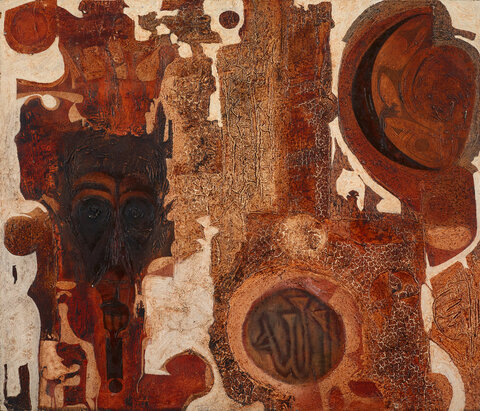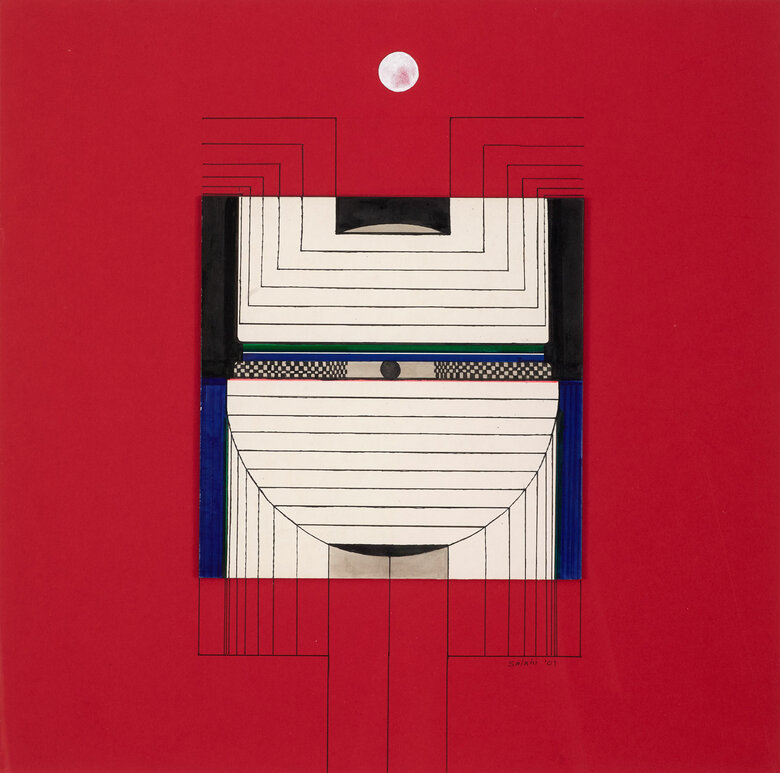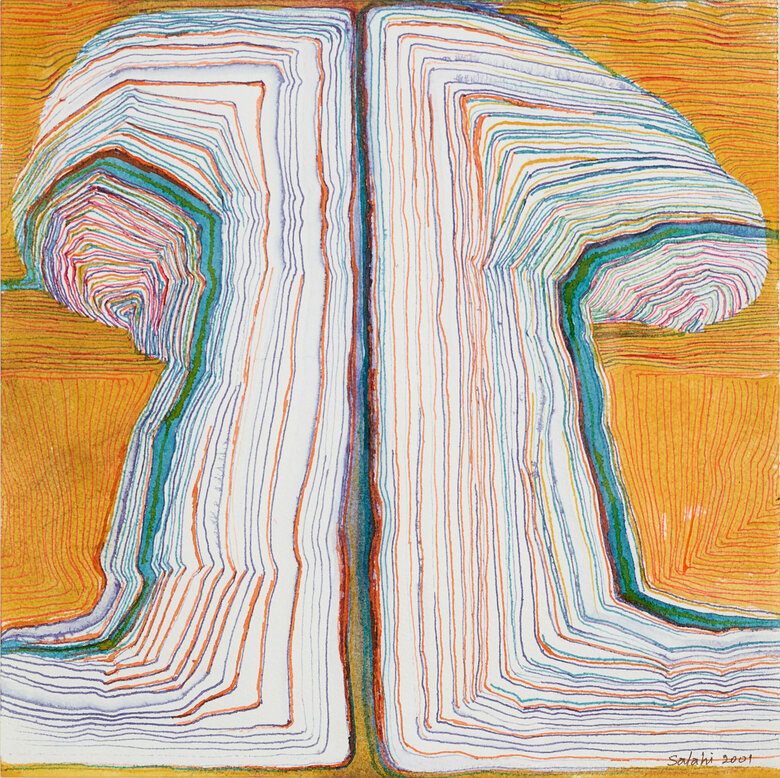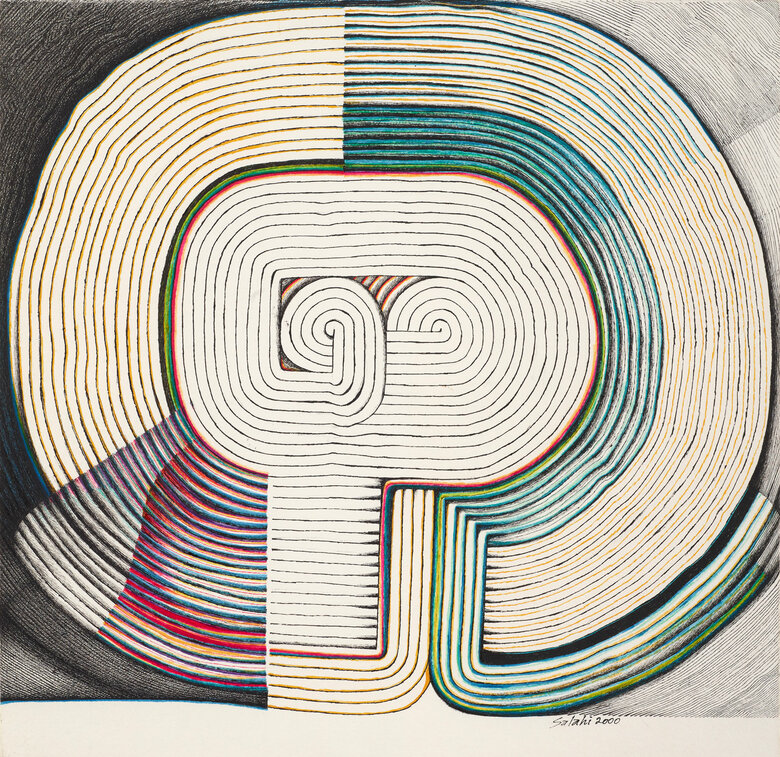Born in 1930 in Omdurman, the second biggest city in Sudan, Ibrahim El Salahi grew up in the district of El Abbasyia in a distinguished family. His grandfather was a judge, and his father, Sheikh...
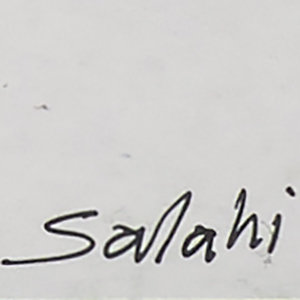

IBRAHIM EL SALAHI, Sudan (1930)
Bio
Written by ARTHUR DEBSI
Born in 1930 in Omdurman, the second biggest city in Sudan, Ibrahim El Salahi grew up in the district of El Abbasyia in a distinguished family. His grandfather was a judge, and his father, Sheikh Mohammed El Salahi Othman, was an Islamic scholar, and taught at the Omdurman Islamic Institute, and the khalwa (Quranic school)[1]. Between 1949 and 1951, he studied in the School of Design at Gordon Memorial College (now the University of Khartoum), an English educational establishment opened in 1902. There, driven by the English teacher Jean-Pierre Greelaw (1910-), he became more attentive to the work on dimensions, proportions, and the structure of the compositions[2]. From the mid-1940s to the early 1960s, the government granted scholarships for around ten Sudanese students to study in Great Britain[3]. Ibrahim El Salahi consequently entered the Slade School of Art in London in 1954. In exchange of providing scholarships, the government requested that the graduates teach at the School of Fine and Applied Arts in Khartoum[4]. After his graduation in 1957, El Salahi came back to Sudan, and dedicated himself in teaching for over two years. He also headed the painting department of the School of Fine and Applied Art in 1960. In 1962, he went to South America, being granted a six1-month Unesco scholarship, and then ended up in New York. In the city, he completed on a one-year scholarship from the Rockefeller Foundation, his training in black-and-white photography in the Department of Journalism, School of General Studies, at Columbia University between 1964 and 1965[5]. Back in his homeland, the artist saw his career disrupted in September 1975, when he was arrested, and put in Cooper Prison by the authorities of President Gaafar Nimeiri (1930-2009). He was falsely accused of carrying out antigovernmental activities[6]. After six months of incarceration, he was released, and left Khartoum for Doha, where he worked as a translator. After seventeen years of exile in Qatar, he eventually settled in Oxford in 1998.
Founded in Ibadan, Nigeria, in 1961, by the German teacher Ulli Beier (1922-2011) and his wife, the first Mbari club was a cultural establishment dedicated to the promotion of African arts and literature. Ibrahim El Salahi was an active member of this organization to the extent that he became the first African artist to hold a solo exhibition in November 1961[7].
While he was a student in London, Ibrahim El Salahi followed an academic education, which focused on the realistic representation of the subjects like portraits, and landscapes, and the use of oil painting[8]. He was also exposed to works from avant-garde movements that were developing in Europe at that time[9]. In parallel, he studied calligraphy, and somehow reconnected to his roots, and his family background: his father was also a fine transcriber of the Qur’an[10]. This experience abroad marked a key phase in the artist’s career in Sudan. In the early 1960s, El Salahi traveled around the country: ‘(…) I was amazed to rediscover the riches I had seen all around me during my childhood, (…). But for the research triggered by the shock of that first show, I would have been unable to see that an aesthetic and cultural alternative had always been available to Sudanese artists, an alternative as meaningful as the foreign one we had tended to embrace’[11]. The importance of the Sudanese cultural, and artistic history that the artist claimed, was the cornerstone of what is named the ‘School of Khartoum’, initiated in the late 1950s. Contrary to other modern artistic movements in the Arab world, this was not a formal group of artists, working together and guided by a specific manifesto, but more a development phase of a creation process in the artists’ works.
The land of Sudan has always been a place where multiple civilizations and religions have crossed paths, such as Islamic, African, and Christian. In a postcolonial context, the first stage of Ibrahim El Salahi’s oeuvre is specifically characterized by this approach of reviving the Sudanese identity. From the 1960s to the 1970s, the painter experimented the combination of African decorative pattern with Islamic visual references, as seen in the work entitled Allah and the Wall of Confrontation (1962), part of the Dalloul Art Foundation’s collection. In this relevant example, he integrated a humanlike face with abstracted features – like an African mask –, and created a dynamic rhythm with lines, and shapes. Applying earthy color tones, he rendered the rough appearance of the composition with profound texture, and somehow recalled mural paintings present in Africa. The treatment is peculiar since El Salahi effectively painted with his hands, seeing this creative experience as a physical connection between him, and the work[12]. Through an imaginary scene, the spiritual and religious aspect is intense, as the artist also wrote the name ‘Allah’ (God) surrounded by a circle. This corresponds his personal idea, that the human life is related to the realm of dreams, and meditations[13].
After his time in jail, and in exile, Ibrahim El Salahi explored the process of meditation, which is highly present in the works, as of the early 2000s. He largely employed the calligraphy to also express his attachment to religion, and considered his art to be a translation of his own faith. Especially in copying the Holy Qur’an, the art of calligraphy is esteemed as a sacred practice, in the sense that it turns into an act of devotion[14]. Linking the creator with the created, the calligrapher is consequently esteemed as the finest artist in the field. Muslim and part of the sophist sect called ‘Khatmyia’[15], he said: ‘(…) Meditation is the real unity with God. When you recite the names of the Lord, (…), then you are communicating directly with God’[16]. In the work Huwa (2000), also part of the Dalloul Art Foundation’s collection, the artist kept the religious dimension of the term meaning ‘He’, which commonly refers to God. Here, he evoked the concept of Sufism, which insists on the supreme divine unity[17]. However, he treated the essence of this concept in a modern approach, drawing a sort of labyrinth with the shapes of the letters, and gave this impression of infinity, and repetition. He reorganized the lines, and made the representation more vivid.
Until recently, El Salahi has been captivated by the haraz, a typical tree of the Sudanese desert landscape. Growing on the banks of the Nile, this tree is resistant to water during the rainy season, and blossoms during the dry season[18]. Part of this large series of paintings, the three examples present in DAF’s collection, all executed in 2001, show this new work on calligraphy to illustrate the subject of the tree, as he asserted: ‘When I see trees growing, you can see the calligraphic shape in them’[19]. Employing vibrant colors, the artist shaped the trunk, and the branches, with simple and continuous lines, while leaving blank spaces, in a minimalist way. The image is completely abstracted, but the symbol is strong: the tree connects the ground with heaven[20]. On another level, El Salahi imagines the human beings like trees; each of them contributes to bring something to the world[21].
The oeuvre of Ibrahim El Salahi is a rich combination of artistic identities, and traditions, from the West, Africa, and Islamic civilization. Through his path, he worked on forming an innovative plastic language, and technique, that made him a prominent figure of transnational modernism of the 20th century.
Ibrahim El Salahi lives and works in Oxford, Great Britain.
Notes
[1] Salahi, Ibrahim El, ‘The Artist in His Own Words’ in Salahi, Ibrahim El, Salah M. Hassan, and Sarah Adams. Ibrahim El-Salahi: a Visionary Modernist. Long Island City, NY, USA: Museum for African Art, 2012. [P.81]
[2] Salahi, Ibrahim El, ‘The Artist in His Own Words’ in Salahi, Ibrahim El, Salah M. Hassan, and Sarah Adams. Ibrahim El-Salahi: a Visionary Modernist. Long Island City, NY, USA: Museum for African Art, 2012. [P.83]
[3] Nour, Amir. ‘Three Years of Teaching Art in Khartoum, 1962-1965’ in Lenssen, Anneka, A. Rogers, Sarah, and Shabout, Nada. Modern Art in the Arab World, Primary Documents. New York, USA: The Museum of Modern Art, 2018. [P.211]
[4] Nour, Amir. ‘Three Years of Teaching Art in Khartoum, 1962-1965’ in Lenssen, Anneka, A. Rogers, Sarah, and Shabout, Nada. Modern Art in the Arab World, Primary Documents. New York, USA: The Museum of Modern Art, 2018. [P.211]
[5] Hassan, Salah M. ‘Ibrahim El-Salahi and the Making of African and Transnational Modernism’ in Salahi, Ibrahim El, Salah M. Hassan, and Sarah Adams. Ibrahim El-Salahi: a Visionary Modernist. Long Island City, NY, USA: Museum for African Art, 2012. [P.13]
[6] Hassan, Salah M. ‘Prison Notebook : A Visual Memoir’ in Salahi, Ibrahim El, Salah M. Hassan, and Sarah Adams. Ibrahim El-Salahi: a Visionary Modernist. Long Island City, NY, USA: Museum for African Art, 2012. [P.93]
[7] Okeke-Agulu, Chika. « Ibrahim El-Salahi and Postcolonial Modernism in the Independence Decade” in Salahi, Ibrahim El, Salah M. Hassan, and Sarah Adams. Ibrahim El-Salahi: a Visionary Modernist. Long Island City, NY, USA: Museum for African Art, 2012. [P.30]
[8] Salahi, Ibrahim El, and Lena Fritsch. Ibrahim El-Salahi: a Sudanese Artist in Oxford. Oxford, Great Britain: Ashmolean, 2018. [.P13]
[9] Beverly, Andrews. “A Visionary Modernist.” New African Magazine, July 31, 2018. https://newafricanmagazine.com/3993/.
[10] Salahi, Ibrahim El, ‘The Artist in His Own Words’ in Salahi, Ibrahim El, Salah M. Hassan, and Sarah Adams. Ibrahim El-Salahi: a Visionary Modernist. Long Island City, NY, USA: Museum for African Art, 2012. [P.81]
[11] Salahi, Ibrahim El, ‘The Artist in His Own Words’ in Salahi, Ibrahim El, Salah M. Hassan, and Sarah Adams. Ibrahim El-Salahi: a Visionary Modernist. Long Island City, NY, USA: Museum for African Art, 2012. [P.87]
[12] Adams, Sarah. "In my Garment there is nothing but God: recent work by Ibrahim el Salahi." African Arts 39, no. 2, 2006. Gale Literature Resource Center (accessed June 5, 2020). [P.28]
[13] Adams, Sarah. "In my Garment there is nothing but God: recent work by Ibrahim el Salahi." African Arts 39, no. 2, 2006. Gale Literature Resource Center (accessed June 5, 2020). [P.14]
[14] Ekhtiar, Maryam. How to Read Islamic Calligraphy. New York, USA: The Metropolitan Museum of Art, 2018. [P.17]
[15] Salahi, Ibrahim El, ‘The Artist in His Own Words’ in Salahi, Ibrahim El, Salah M. Hassan, and Sarah Adams. Ibrahim El-Salahi: a Visionary Modernist. Long Island City, NY, USA: Museum for African Art, 2012. [P.81]
[16] Ibrahim El-Salahi interviewed by Ulli Beier conducted in Salahi, Ibrahim El, Salah M. Hassan, and Sarah Adams. Ibrahim El-Salahi: a Visionary Modernist. Long Island City, NY, USA: Museum for African Art, 2012. [P.109]
[17] Schimmel, Annemarie. “Sufism.” Encyclopædia Britannica. Encyclopædia Britannica, inc., November 20, 2019. https://www.britannica.com/topic/Sufism.
[18] Hassan, Salah M. ‘Ibrahim El-Salahi and the Making of African and Transnational Modernism’ in Salahi, Ibrahim El, Salah M. Hassan, and Sarah Adams. Ibrahim El-Salahi: a Visionary Modernist. Long Island City, NY, USA: Museum for African Art, 2012. [P.24]
[19] Ibrahim El Salahi quoted in Adams, Sarah. "In my Garment there is nothing but God: recent work by Ibrahim el Salahi." African Arts 39, no. 2, 2006. Gale Literature Resource Center (accessed June 5, 2020). [P.6]
[20] Adams, Sarah. "In my Garment there is nothing but God: recent work by Ibrahim el Salahi." African Arts 39, no. 2, 2006. Gale Literature Resource Center (accessed June 5, 2020). [P.32]
[21] Adams, Sarah. "In my Garment there is nothing but God: recent work by Ibrahim el Salahi." African Arts 39, no. 2, 2006. Gale Literature Resource Center (accessed June 5, 2020). [P.32]
Sources
Adams, Sarah. "In my Garment there is nothing but God: recent work by Ibrahim el Salahi." African Arts 39, no. 2, 2006. Gale Literature Resource Center (accessed June 5, 2020).
Eigner, Saeb. Art of the Middle-East, Modern and Contemporary Art of the Arab World and Iran. London, UK: Merell Publishers Limited, 2011.
Ekhtiar, Maryam. How to Read Islamic Calligraphy. New York, USA: The Metropolitan Museum of Art, 2018.
Hopkins, Peter Gwynvay. The Kenana Handbook of Sudan. London ; New York, Great Britain, USA: Routledge, 2016.
Lenssen, Anneka, A. Rogers, Sarah, and Shabout, Nada. Modern Art in the Arab World, Primary Documents. New York, USA: The Museum of Modern Art, 2018.
Salahi, Ibrahim El. Ibrahim El-Salahi. London, Great Britain: Vigo Gallery, 2016.
Salahi, Ibrahim El, and Lena Fritsch. Ibrahim El-Salahi: a Sudanese Artist in Oxford. Oxford, Great Britain: Ashmolean, 2018.
Salahi, Ibrahim El, Salah M. Hassan, and Sarah Adams. Ibrahim El-Salahi: a Visionary Modernist. Long Island City, NY, USA: Museum for African Art, 2012.
Schimmel, Annemarie. “Sufism.” Encyclopædia Britannica. Encyclopædia Britannica, inc., November 20, 2019. https://www.britannica.com/topic/Sufism.
Shabout, Nada. Modern Arab Art: Formation of Arab Aesthetics. Gainesville, USA: University Press of Florida, 2015.
Beverly, Andrews. “A Visionary Modernist.” New African Magazine, July 31, 2018. https://newafricanmagazine.com/3993/.
“Ibrahim El-Salahi: A Visionary Modernist, London.” Aesthetica Magazine, 2017. http://www.aestheticamagazine.com/ibrahim-el-salahi-a-visionary-modernist-london/.
Al-Shahi, Ahmed S., and Jay L. Spaulding. “The British Conquest.” Encyclopædia Britannica. Encyclopædia Britannica, inc., January 29, 2020. https://www.britannica.com/place/Sudan/The-British-conquest.
Dwider, Sarah. “‘Understood and Counted’: A Conversation with Ibrahim El-Salahi.” Guggenheim, December 13, 2016. https://www.guggenheim.org/blogs/checklist/understood-and-counted-a-conversation-with-ibrahim-el-salahi.
The Editors of Encyclopaedia Britannica. “Mbari Mbayo Club.” Encyclopædia Britannica. Encyclopædia Britannica, inc., March 16, 2001. https://www.britannica.com/topic/Mbari-Mbayo-Club.
CV
Selected Solo Exhibitions
2024
Ibrahim El-Salahi: No Shade but His Shade, Vigo Gallery (Mason's Yard), St. James's, London, UK
Ibrahim El-Salahi: Haraz, Vigo Gallery (Wellington Arch), London, UK
Ibrahim El-Salahi: Behind the Mask | Milk of Dreams, Vigo Gallery (Mason's Yard), St. James's, London, USA
2023
Ibrahim El-Salahi: Pain Relief Drawings, Kunsthalle Zürich, Zürich, Switzerland
2022
Ibrahim El-Salahi: Pain Relief, Hastings Contemporary, Hastings, UK
Ibrahim El-Salahi: Black and White, Vigo Gallery (Mason's Yard), St. James's, London, UK
, The Drawing Center, Soho, New York, USA
2019
Pain Relief, Vigo Gallery, Saatchi Gallery, London, UK
Ibrahim El-Salahi: War Within, War Without, Vigo Gallery (Mason's Yard), St. James's, London, UK
2018
Meditation Tree, Courtyard Installation, Vigo Gallery at 1:54, Somerset House, London, UK
By His Will We Teach Birds How to Fly: Ibrahim El-Salahi in Black and White, Vigo Gallery, London, UK
A Sudanese Artist in Oxford, Ashmolean Museum, Oxford, UK
2017
By His Will We Teach Birds How to Fly: Ibrahim El-Salahi in Black and White, Prince Claus Fund Gallery, Amsterdam, Netherlands
2016
Ibrahim El-Salahi, Vigo Gallery, Art Basel Miami Beach, Miami Beach, US
Alhambra, Salon 94, New York, US
Ibrahim El-Salahi, Vigo Gallery, The Armory Show, New York, US
2015
The Arab Spring Notebook, Galerist, Istanbul, Turkey
Flamenco, Vigo Gallery, London, UK
Ibrahim El-Salahi, Vigo Gallery, Frieze New York, US
Haraza, Jerwood Gallery, Hastings, UK
2014
The Tree, Vigo Gallery, London, UK
Selected Works, 1962-2010, Skoto Gallery, New York, US
2013
Ibrahim El-Salahi: A Visionary Modernist, Tate Modern, London, UK
2012
Ibrahim El-Salahi: A Visionary Modernist, Katara Cultural Village Foundation, Doha, Qatar; Sharjah Art Foundation, UAE
2011
From Time to Time, Skoto Gallery, New York, NY, US
2010
Rashid Diab Arts Centre, Khartoum, Sudan
2000
Dara Art Gallery, Khartoum, Sudan
1992
Savannah Gallery, London, UK
1990
Iwalewa-Haus, Contemporary African Art Centre, Bayreuth, Germany
1984
Iwalewa-Haus, Contemporary African Art Centre, Bayreuth, Germany
1974
Art Gallery of the National Council for Arts and Letters, Kuwait
1972
Agisymba Gallery, Berlin, Germany
1969
French Cultural Centre, Khartoum, Sudan
1967
Galerie Lambert, Paris, France
Traverse Gallery, Edinburgh, UK
French Cultural Centre, Khartoum, Sudan
1966
Carl Durisberg, Munich, Germany
1964
Daberkow Gallery, Frankfurt, Germany
Irvington-on-Hudson, NY, US
1963
Murphy Gallery, Baltimore, MD, US
Middle East House, Washington DC, US
ICA Gallery, London, UK
1962
Galerie Lambert, Paris, France
American Cultural Center, Khartoum, Sudan
1961
Mbari Gallery, Ibadan, Nigeria
1960
Grand Hotel Exhibition Hall, Khartoum, Sudan
Selected Group Exhibitions
2024
African Modernism in America, Taft Museum of Art, Cincinnati, Ohio, USA
Unlimited III: The African Family, Gallery 1957, Accra, Ghana
Drawing Time: Duets, Sharjah Art Foundation, Sharjah, United Arab Emirates
2023
African Modernism in America, Mildred Lane Kemper Art Museum, St. Louis, Missouri, USA
Modern and Contemporary Art of the Arab World, Christie’s London, St. James's, London, UK
In the Heart of Another Country: The Diasporic Imagination Rises, Sharjah Art Foundation, Sharjah, United Arab Emirates
African Modernism in America, 1947-67, The Phillips Collection, Washington D.C., District Of Columbia, USA
2020
Home is a Foreign Place, The Met Breuer, New York, US
Into the Night: Cabarets and Clubs in Modern Art, Belvedere, Vienna
New Images of Man, Blum & Poe, Los Angeles, US
Taking Shape: Abstraction from the Arab World, 1950-1980s, Grey Art Gallery, New York, US
2019
War Within, War Without, Museum of Modern Art, New York, US
Many Tongues: Art, language, and Revolution in the Middle East and South Asia, Museum of Contemporary Art, Chicago (MCA), US
Into the Night: Cabaret and Clubs in Modern Art, Barbican, London, UK
Kubatana, Vestfossen Kunstlaboratorium, Vestfossen, Norway
The Armory Show, Vigo Gallery, New York, US
2018
Forest and Spirits: Figurative Art From the Khartoum School, Saatchi Gallery, London, UK
A Century in Flux, Sharjah Art Museum, Sharjah, UAE
Histórias Afro-Atlânticas, (MASP) Museu de Arte de São Paulo Assis Chateaubriand, Brazil
Tree, Vigo Gallery, London, UK
Masterpiece, Vigo Gallery, London, UK
2017
Ibrahim El-Salahi and William Turnball, Sotheby S|2 Gallery, London, UK
Art Basel, Salon 94, Basel, Switzerland
Treasures of Islam in Africa from Timbuktu to Zanzibar, Arab World Institute, Paris, France
The Armory Show, Vigo Gallery, New York, US
Protest, Museum of Modern Art, New York, NY, US
Lines of Subjectivity: Portrait and Landscape Painting, Jordan National Gallery of Fine Arts, Amman, Jordan
2016
Post-War: Art Between the Pacific and the Atlantic, 1945-1965, Haus der Kunst, Munich, Germany
The Khartoum School: The Making of the Modern Art Movement in Sudan (1945 – Present), Sharjah Art Foundation, Sharjah, UAE
Kaleidoscope, Modern Art Oxford, Oxford, UK
Making and Unmaking, Camden Arts Centre, London, UK
2015
Wondrous Worlds: Arts and Islam through Time and Place, Newark Museum, Newark, NJ, US
2014
Sky Over The East, Emirates Palace, UAE
2011
Meem Gallery, Dubai, UAE
2010
Sajjil, Mathaf Arab Museum of Modern Art, Doha, Qatar
Tradition of the Future, Future of Tradition, Haus der Kunst, Munich, Germany
Selections, Skoto Gallery, New York, NY, US
Interventions, The Arab Museum of Modern Art, Doha, Qatar
2004
The Oxford Show, Modern Art Oxford, Oxford, UK
Sudan: Past and Present, The British Museum, London, UK
2003
Asylum Years, Oxford Brookes University, Oxford, UK
2001
The Short Century, Museum Villa Stuck, Munich; Haus der Kulturen der West, Berlin, Germany; Museum of Contemporary Art, Chicago, IL; Museum of Modern Art, New York, US
Century City: Art and Culture in the Modern Metropolis, Tate Modern, London, UK
20th Anniversary of Iwalewa-Haus, Iwalewa-Haus, Bayreuth, Germany
2000
L’Afrique à Jour, Lille, France
Contemporary Sudanese Art, Durham University Oriental Museum, Durham, UK
Blackness in Colour, Howard Johnson Art Museum, Cornell University, Ithaca, NY, US
1999
Sharjah International Arts Biennale, Sharjah, UAE
Contemporary Sudanese Art, Cardiff, UK
1998
Art Sans Frontières, Maison de l’UNESCO, Salle Miro, Paris, France
1996
Malmö Konsthall, Malmö, France
1995
Africa 95: Seven Stories of Art from Africa, Whitechapel Art Gallery, London, UK
Sharjah International Arts Biennale, Sharjah, UAE
1994
Savannah Gallery, London, UK
1992
Laing Art Gallery, Newcastle-upon-Tyne, UK
1991
A Grain of Wheat, Art Relief for Africa, Art Gallery Commonwealth Institute, London, UK
Paradox of the New: Art from Africa, South Square Gallery, London, UK
1978
Maison de la Culture André Malraux, Reims, France
1977
Festac, Lagos, Nigeria
1976
Bab Elloog Art Gallery, Cairo, Egypt
1975
Georgetown University Hall, Washington DC, US
African Art Then and Now, Royal Commonwealth Society, London, UK
1974
Khartoum Art Gallery, Khartoum, Sudan
Museum of African Art, Washington DC, US
1971
Africa Centre, London, UK
1970
Trinity College, Dublin, Ireland
Abgeordneten-Hochhaus des Deutschen Bundestages, Bonn, Germany
1969
Nommo Gallery, Kampala, Uganda
Contemporary Art in Africa, Camden Arts Centre, London, UK
Pan-African Cultural Festival, Algiers, Algeria
1967
Contemporary Art in Africa, ICA Gallery, London, UK
1966
Museum of Philadelphia Civic Centre, Philadelphia, US
Museum of Modern Art, New York, US
1963
Academy of Fine Art, Calcutta, India
Awards and Honors
2015
Honorary Doctor of Literature (DLit), University College London, London, UK
2004
Gold Medal, Festival International des Arts Plastiques des Mahrès, Tunisia
2001
Prince Claus Fund Award, Amsterdam, Netherlands
1999
Honorary Award, Sharjah International Arts Biennale, Sharjah, UAE
1975
Silver Medal, Order of Knowledge, Arts and Letters of Democratic Republic of Sudan, Sudan
1971
Gold Medal, Order of Knowledge, Arts and Letters of Democratic Republic of Sudan, Sudan
Collections
Art Institute of Chicago, Chicago, US
Ashmolean Museum, Oxford, UK
Ramzi and Saeda Dalloul Art Foundation, Beirut, Lebanon
Barjeel Art Foundation, Sharjah, UAE
British Museum, London, UK
Betty Parsons Gallery, New York, US
Collection Lambert, Avignon, France
Department of Culture, Khartoum, Sudan
Guggenheim Abu Dhabi, Abu Dhabi, UAE
Hampton University Museum, Hampton, Virginia, US
Hood Museum of Art, Hanover, New Hampshire, US
Howard Johnson Museum, Cornell University, Ithaca, NY, US
Iwalewahaus, Contemporary African Art Centre, Bayreuth, Germany
Mathaf: Arab Museum of Modern Art, Doha, Qatar
Mbari Gallery, Ibadan, Nigeria
Metropolitan Museum, New York, US
Museum of Modern Art, New York, US
National Council of Culture, Arts and Letters, Kuwait City, Kuwait
National Gallery, Berlin, Germany
National Gallery of Victoria, Sydney, Australia
Newark Museum, Newark, New Jersey, US
Newcastle Art Gallery, Newcastle, NSW, Australia
Sharjah Art Foundation, Sharjah, UAE
Press
Africanpainters.pdf
500wordsmag.pdf
Alquds Newspaper.pdf
english-aawsat.pdf
Artist Dossier_ Ibrahim El-Salahi - Omenka Online.pdf
Aestheticamagazine.pdf
ArtDaily.pdf
ArtReview.com.pdf
Africanah.pdf
daily-norm.com.pdf
AfricaSpeaks4Africa.pdf
_Prison Notebook__ How Sudanese artist Ibrahim El Salahi transformed his suffering into seminal works - The National.pdf
Ibrahim El Salahi_ Selected Works, 1962-2010 - Contemporary AndContemporary And.pdf
Ibrahim El-Salahi – Modern Forms.pdf
Jerwoodgallery.pdf
Guggenheim.pdf
Independent.pdf
Frieze.pdf
Nafas.pdf
NYTimes.pdf
التشكيلي العالمي ابراهيم الصلحي في حوار مع ألوان صحيفة ألوان.pdf
طباعة - عميد التشكيليين السودانيين إبراهيم الصلحي.pdf
الجزيرة.نت.pdf
نظرة على عالم إبراهيم الصلحي من خلال أول معرض له في بريطانيا.pdf
TimeOut.pdf
الفنان إبراهيم الصلحي (صرماطي) يسجل حضوره الفاعل - صحيفة الراكوبة.pdf
Telegraph.pdf
بصيريات المُعلم إبراهيم الصَلَحي - جريدة الاتحاد.pdf
سودارس _ التشكيلي ابراهيم الصلحي شاهد على عصره(1).pdf
Tqsmagazine.pdf
Tate.org.pdf
What is African art Financial Times.pdf
Untitled.pdf
TheGuardian.pdf
Ibrahim El-Salahi_ a Sudanese artist in Oxford Apollo Magazine.pdf
Dissecting a gallery in a remade MoMA The Art Newspaper.pdf
Artist Ibrahim El-Salahi_ ‘When I work, I don’t feel pain at all’ Financial Times.pdf
Ibrahim El-Salahi_ Painting In Pursuit Of A Cultural Identity.pdf
Exhibitions
IBRAHIM EL SALAHI Artwork
Become a Member
Join us in our endless discovery of modern and contemporary Arab art
Become a Member
Get updates from DAF
Follow Artists
Save your favourite Artworks
Share your perspectives on Artworks
Be part of our community
It's Free!
We value your privacy
TermsCookiesPrivacy Policies
Become a Member
Get updates from DAF
Follow Artists
Save your favourite Artworks
Share your perspectives on Artworks
Be part of our community
It's Free!
We value your privacy
TermsCookiesPrivacy Policies
Become a Member
Get updates from DAF
Follow Artists
Save your favourite Artworks
Share your perspectives on Artworks
Be part of our community
It's Free!
We value your privacy
TermsCookiesPrivacy Policies
Welcome to the Dalloul Art Foundation
Thank you for joining our community
If you have entered your email to become a member of the Dalloul Art Foundation, please click the button below to confirm your email and agree to our Terms, Cookie & Privacy policies.
We value your privacy, see how
Become a Member
Get updates from DAF
Follow Artists
Save your favourite Artworks
Share your perspectives on Artworks
Be part of our community
It's Free!
We value your privacy
TermsCookiesPrivacy Policies

